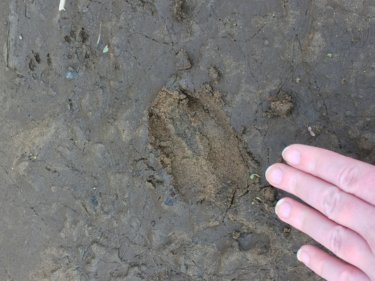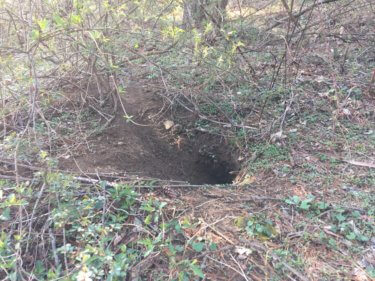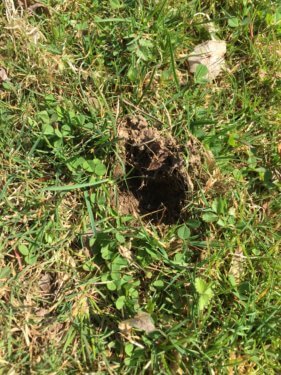diggin’ in
This week is all about dirt and the amazing potato.
This week is all about dirt and the amazing potato.
Today we have something to watch, an animal print in the mud, and activities you can do. Let’s get to digging!
to watch.
As a part of Longwood Gardens Community Reads we are sharing this fun read aloud of The Enormous Potato.
https://www.youtube.com/watch?v=k74g0q48lgM
nature ID challenge.
Today’s Nature ID Challenge is a common one. This track was found in the sand near the creek at Crow’s Nest Preserve. Think you know what it is?

Answer: A white-tailed deer (Odocoileus virginianus), which is the only hooved wild animal in this part of Pennsylvania.
fun facts.
Did you ever wonder what the difference is between a fruit and a vegetable? Botanically speaking fruits come from a flower, and everything else is a vegetable. Fruits contain seeds while vegetables are stems, roots, and leaves. Which do you think a potato is?
Click here for more fun crafts, snacks, and activities with vegetables.
Click here for more fun activities with fruit.
grow.
Did you know that you can grow potatoes in water? It’s true!
When they start sprouting, take them outdoors to plant in your backyard or in a large bucket. You can even use an old trash can! If you don’t have a potato, there are lots of vegetables you can regrow in water. Learn how.
nature ID challenge.
We’re branching out from tracks—who knows what’s happening in today’s picture? And do you know what family of species is represented (since the specific species is hard to identify in this case)?

Answer: This is an acorn, putting a root down into the soil. It’s hard to tell just based on the acorn, but based on the combination of the shape of the acorn and the trees nearby, this is probably the acorn from some type of red oak.
fun facts.
Most plants grow from seeds, but potatoes are a root vegetable. Roots are parts of a plant that usually grow downward, anchoring the plant into the ground, where they absorb moisture and nutrients. Examples of root vegetables include beets, carrots, celeriac, parsnips, and turnips.
Potatoes are a starchy tuber native to the Americas. Tubers form at the base of roots and store energy in the form of starch to support new stem growth for the plant. Examples of tubers include potatoes, Jerusalem artichokes, jicama, and yams.
If you have some seeds in your pantry—even dried beans will work—try this at home and compare your potato in water to the seed in a bag: Seed jar science experiment.
craft.
It’s time to play! Here are two potato crafts you can make at home.
Did you know you can make a stamp out of a potato? No knife needed. Learn how.
You can turn a potato into a toy! Craft your own Potato Head out of real potatoes. Learn how.
nature ID challenge.
This hole in the ground was found in a hedgerow between two farm fields. The hole is about 9 to 12 inches in diameter. Can you figure out what animal made it?

Answer: Although we can’t say with complete certainty without seeing the animal, we believe that this is a groundhog den. Groundhogs often have large throw piles of dirt outside the main entrance to the den, and the hole is usually between 6 and 11 inches wide. They often make dens either in or near meadows. Groundhog dens can be taken over by foxes, but since there are no fox tracks or scat nearby, we don’t think that’s the case here.
cook.
It’s time to get cooking! Potato chips are delicious and easy to make. You can even cook them in your microwave.
recipe for microwave potato chips
Get creative with your potato chip toppings and make snack time into a taste test.
potato fun
Want to learn more about potatoes? Pennsylvania Cooperative Potato Growers has a ton of information, and a great teachers page with coloring pages, word searches, and trivia. Check it out!
nature ID challenge.
To wrap up the week, we have an extra-hard challenge! This small hole was scraped in the lawn near the Crow’s Nest Visitor’s Center. It’s not deep—the animal just scraped aside the grass to get to the dirt—but there are many others like it around the yard. Can you figure out what animal made this?

Stuck? Here are some hints:
Answer: These scrapes in the yard were made by skunks searching for grubs in the dirt! These insect-loving critters will come out at night and dig around to find some tasty insects to eat.